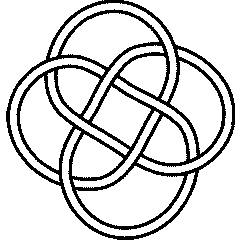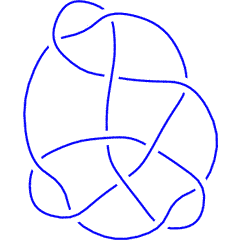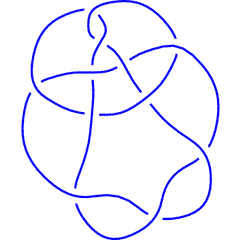The Alexander-Conway Polynomial: Difference between revisions
CochiRacde (talk | contribs) No edit summary |
No edit summary |
||
| (One intermediate revision by one other user not shown) | |||
| Line 1: | Line 1: | ||
http://www.textdartasitla.com |
|||
{{Manual TOC Sidebar}} |
{{Manual TOC Sidebar}} |
||
| Line 7: | Line 6: | ||
<!--Robot Land, no human edits to "END"--> |
<!--Robot Land, no human edits to "END"--> |
||
{{HelpAndAbout| |
{{HelpAndAbout| |
||
n = |
n = 2 | |
||
n1 = |
n1 = 3 | |
||
in = <nowiki>Alexander</nowiki> | |
in = <nowiki>Alexander</nowiki> | |
||
out= <nowiki>Alexander[K][t] computes the Alexander polynomial of a knot K as a function of the variable t. Alexander[K, r][t] computes a basis of the r'th Alexander ideal of K in Z[t].</nowiki> | |
out= <nowiki>Alexander[K][t] computes the Alexander polynomial of a knot K as a function of the variable t. Alexander[K, r][t] computes a basis of the r'th Alexander ideal of K in Z[t].</nowiki> | |
||
| Line 17: | Line 16: | ||
<!--Robot Land, no human edits to "END"--> |
<!--Robot Land, no human edits to "END"--> |
||
{{HelpLine| |
{{HelpLine| |
||
n = |
n = 4 | |
||
in = <nowiki>Conway</nowiki> | |
in = <nowiki>Conway</nowiki> | |
||
out= <nowiki>Conway[K][z] computes the Conway polynomial of a knot K as a function of the variable z.</nowiki>}} |
out= <nowiki>Conway[K][z] computes the Conway polynomial of a knot K as a function of the variable z.</nowiki>}} |
||
| Line 29: | Line 28: | ||
<!--Robot Land, no human edits to "END"--> |
<!--Robot Land, no human edits to "END"--> |
||
{{InOut| |
{{InOut| |
||
n = |
n = 5 | |
||
in = <nowiki>alex = Alexander[Knot[8, 18]][t]</nowiki> | |
in = <nowiki>alex = Alexander[Knot[8, 18]][t]</nowiki> | |
||
out= <nowiki> -3 5 10 2 3 |
out= <nowiki> -3 5 10 2 3 |
||
| Line 40: | Line 39: | ||
<!--Robot Land, no human edits to "END"--> |
<!--Robot Land, no human edits to "END"--> |
||
{{InOut| |
{{InOut| |
||
n = |
n = 6 | |
||
in = <nowiki>Expand[Conway[Knot[8, 18]][Sqrt[t] - 1/Sqrt[t]]]</nowiki> | |
in = <nowiki>Expand[Conway[Knot[8, 18]][Sqrt[t] - 1/Sqrt[t]]]</nowiki> | |
||
out= <nowiki> -3 5 10 2 3 |
out= <nowiki> -3 5 10 2 3 |
||
| Line 53: | Line 52: | ||
<!--Robot Land, no human edits to "END"--> |
<!--Robot Land, no human edits to "END"--> |
||
{{InOut| |
{{InOut| |
||
n = |
n = 7 | |
||
in = <nowiki>Abs[alex /. t -> -1]</nowiki> | |
in = <nowiki>Abs[alex /. t -> -1]</nowiki> | |
||
out= <nowiki>45</nowiki>}} |
out= <nowiki>45</nowiki>}} |
||
| Line 63: | Line 62: | ||
<!--Robot Land, no human edits to "END"--> |
<!--Robot Land, no human edits to "END"--> |
||
{{InOut| |
{{InOut| |
||
n = |
n = 8 | |
||
in = <nowiki>KnotDet[Knot[8, 18]]</nowiki> | |
in = <nowiki>KnotDet[Knot[8, 18]]</nowiki> | |
||
out= <nowiki>45</nowiki>}} |
out= <nowiki>45</nowiki>}} |
||
| Line 73: | Line 72: | ||
<!--Robot Land, no human edits to "END"--> |
<!--Robot Land, no human edits to "END"--> |
||
{{InOut| |
{{InOut| |
||
n = |
n = 9 | |
||
in = <nowiki>Coefficient[Conway[Knot[8, 18]][z], z^2]</nowiki> | |
in = <nowiki>Coefficient[Conway[Knot[8, 18]][z], z^2]</nowiki> | |
||
out= <nowiki>1</nowiki>}} |
out= <nowiki>1</nowiki>}} |
||
| Line 83: | Line 82: | ||
<!--Robot Land, no human edits to "END"--> |
<!--Robot Land, no human edits to "END"--> |
||
{{InOut| |
{{InOut| |
||
n = |
n = 10 | |
||
in = <nowiki>Vassiliev[2][Knot[8, 18]]</nowiki> | |
in = <nowiki>Vassiliev[2][Knot[8, 18]]</nowiki> | |
||
out= <nowiki>1</nowiki>}} |
out= <nowiki>1</nowiki>}} |
||
| Line 95: | Line 94: | ||
<!--Robot Land, no human edits to "END"--> |
<!--Robot Land, no human edits to "END"--> |
||
{{In| |
{{In| |
||
n = |
n = 11 | |
||
in = <nowiki>{K1, K2} = {Knot[11, Alternating, 99], Knot[11, Alternating, 277]};</nowiki>}} |
in = <nowiki>{K1, K2} = {Knot[11, Alternating, 99], Knot[11, Alternating, 277]};</nowiki>}} |
||
<!--END--> |
<!--END--> |
||
| Line 102: | Line 101: | ||
<!--Robot Land, no human edits to "END"--> |
<!--Robot Land, no human edits to "END"--> |
||
{{InOut| |
{{InOut| |
||
n = |
n = 12 | |
||
in = <nowiki>Alexander[K1] == Alexander[K2]</nowiki> | |
in = <nowiki>Alexander[K1] == Alexander[K2]</nowiki> | |
||
out= <nowiki>True</nowiki>}} |
out= <nowiki>True</nowiki>}} |
||
| Line 110: | Line 109: | ||
<!--Robot Land, no human edits to "END"--> |
<!--Robot Land, no human edits to "END"--> |
||
{{InOut| |
{{InOut| |
||
n = |
n = 13 | |
||
in = <nowiki>Alexander[K1, 2][t]</nowiki> | |
in = <nowiki>Alexander[K1, 2][t]</nowiki> | |
||
out= <nowiki>{1}</nowiki>}} |
out= <nowiki>{1}</nowiki>}} |
||
| Line 118: | Line 117: | ||
<!--Robot Land, no human edits to "END"--> |
<!--Robot Land, no human edits to "END"--> |
||
{{InOut| |
{{InOut| |
||
n = |
n = 14 | |
||
in = <nowiki>Alexander[K2, 2][t]</nowiki> | |
in = <nowiki>Alexander[K2, 2][t]</nowiki> | |
||
out= <nowiki>{3, 1 + t}</nowiki>}} |
out= <nowiki>{3, 1 + t}</nowiki>}} |
||
| Line 128: | Line 127: | ||
<!--Robot Land, no human edits to "END"--> |
<!--Robot Land, no human edits to "END"--> |
||
{{InOut| |
{{InOut| |
||
n = |
n = 15 | |
||
in = <nowiki>Length /@ {Union[Alexander[#]& /@ AllKnots[]], AllKnots[]}</nowiki> | |
in = <nowiki>Length /@ {Union[Alexander[#]& /@ AllKnots[]], AllKnots[]}</nowiki> | |
||
out= <nowiki>{551, 802}</nowiki>}} |
out= <nowiki>{551, 802}</nowiki>}} |
||
Latest revision as of 18:21, 21 February 2013
(For In[1] see Setup)
|
| ||||||||
| ||||
 8_18 |
The Alexander polynomial and the Conway polynomial of a knot always satisfy . Let us verify this relation for the knot 8_18:
In[5]:=
|
alex = Alexander[Knot[8, 18]][t]
|
Out[5]=
|
-3 5 10 2 3
13 - t + -- - -- - 10 t + 5 t - t
2 t
t
|
In[6]:=
|
Expand[Conway[Knot[8, 18]][Sqrt[t] - 1/Sqrt[t]]]
|
Out[6]=
|
-3 5 10 2 3
13 - t + -- - -- - 10 t + 5 t - t
2 t
t
|
The determinant of a knot is . Hence for 8_18 it is
In[7]:=
|
Abs[alex /. t -> -1]
|
Out[7]=
|
45
|
Alternatively (see The Determinant and the Signature):
In[8]:=
|
KnotDet[Knot[8, 18]]
|
Out[8]=
|
45
|
, the (standardly normalized) type 2 Vassiliev invariant of a knot is the coefficient of in its Conway polynomial:
In[9]:=
|
Coefficient[Conway[Knot[8, 18]][z], z^2]
|
Out[9]=
|
1
|
Alternatively (see Finite Type (Vassiliev) Invariants),
In[10]:=
|
Vassiliev[2][Knot[8, 18]]
|
Out[10]=
|
1
|
 K11a99 |
 K11a277 |
Sometimes two knots have the same Alexander polynomial but different Alexander ideals. An example is the pair K11a99 and K11a277. They have the same Alexander polynomial, but the second Alexander ideal of the first knot is the whole ring while the second Alexander ideal of the second knot is the smaller ideal generated by and by :
In[11]:=
|
{K1, K2} = {Knot[11, Alternating, 99], Knot[11, Alternating, 277]};
|
In[12]:=
|
Alexander[K1] == Alexander[K2]
|
Out[12]=
|
True
|
In[13]:=
|
Alexander[K1, 2][t]
|
Out[13]=
|
{1}
|
In[14]:=
|
Alexander[K2, 2][t]
|
Out[14]=
|
{3, 1 + t}
|
Finally, the Alexander polynomial attains 551 values on the 802 knots known to KnotTheory`:
In[15]:=
|
Length /@ {Union[Alexander[#]& /@ AllKnots[]], AllKnots[]}
|
Out[15]=
|
{551, 802}
|







![{\displaystyle {\mathbb {Z} }[t]}](https://wikimedia.org/api/rest_v1/media/math/render/svg/97a786720fa81d7d0cf7400c3ff3f72e892fbc33)

